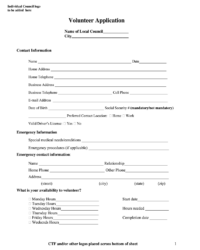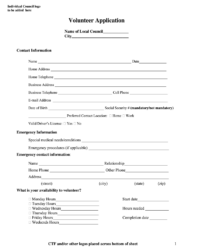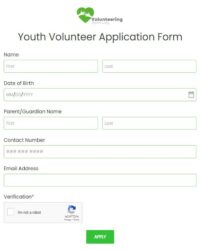Utilizing a consistent structure streamlines the application review process, enabling organizations to quickly identify qualified individuals and expedite their integration into the team. This efficiency is paramount in time-sensitive situations, ensuring rapid deployment of trained personnel when needed. Furthermore, standardized documentation helps ensure fairness and consistency in evaluating applicants, promoting equitable selection practices and strengthening the overall team composition. It also provides a valuable record for the organization, facilitating communication and management of volunteer resources.
This document serves as a crucial first step for those seeking to contribute their skills and time to this vital service. The subsequent sections will delve deeper into specific aspects of the application process, offering detailed guidance and insight for prospective volunteers and organizations alike. Topics covered will include common requirements, essential skills, and the importance of thorough preparation.
Key Components of a Volunteer Search and Rescue Application
Effective applications for search and rescue volunteer positions require specific information to assess a candidate’s suitability. The following components are typically considered essential:
1: Personal Information: Basic identifying information, including full legal name, contact details, and emergency contact information, is necessary for record-keeping and communication.
2: Relevant Skills and Certifications: Documentation of skills such as first aid, wilderness survival, navigation, and communication, as well as relevant certifications (e.g., Wilderness First Responder, EMT), are crucial for evaluating a candidate’s preparedness.
3: Availability and Commitment: A clear indication of the applicant’s availability for training, deployments, and meetings provides insight into their level of commitment and allows organizations to schedule resources effectively.
4: Physical Fitness and Medical History: Search and rescue operations can be physically demanding. Information regarding physical fitness levels, relevant medical history, and any physical limitations ensures the safety of the volunteer and the team.
5: Experience and Background: Prior experience in related fields (e.g., outdoor recreation, emergency services) or volunteer work can demonstrate valuable skills and adaptability.
6: References: Contact information for individuals who can attest to the applicant’s character, skills, and experience offers valuable third-party validation.
7: Motivation and Interests: Understanding an applicant’s reasons for wanting to join a search and rescue team provides insight into their commitment and suitability for this type of volunteer service.
Thorough completion of these sections facilitates efficient evaluation and selection of suitable candidates, contributing to the overall effectiveness of search and rescue operations.
How to Create a Volunteer Search and Rescue Application Template
Developing a standardized application form ensures consistency and efficiency in the volunteer recruitment process for search and rescue organizations. Careful consideration of key elements ensures the collection of necessary information for effective candidate assessment.
1: Define Essential Information: Determine the specific information required from applicants based on the organization’s needs and the demands of search and rescue operations. This typically includes personal details, skills, certifications, availability, physical fitness information, experience, references, and motivation.
2: Structure the Application Logically: Organize the application into clear sections with descriptive headings. A logical flow facilitates easy completion by applicants and efficient review by the organization.
3: Use Clear and Concise Language: Employ straightforward language and avoid jargon or technical terms that may confuse potential applicants. Clarity ensures all applicants understand the questions and can provide accurate responses.
4: Ensure Accessibility: Consider providing the application in multiple formats (e.g., online, printable) to accommodate diverse applicant needs and preferences. Accessibility maximizes the potential pool of applicants.
5: Incorporate Legal and Ethical Considerations: Include necessary disclaimers and ensure compliance with relevant data privacy regulations. This protects both the organization and the applicants.
6: Pilot Test the Application: Before widespread implementation, test the application with a small group of individuals to identify any areas for improvement in clarity, flow, or completeness. Pilot testing ensures a refined and effective final product.
7: Establish a Review Process: Develop a standardized process for reviewing completed applications, ensuring consistent evaluation criteria and efficient decision-making. This promotes fairness and transparency in volunteer selection.
A well-designed application template streamlines the volunteer recruitment process, enabling search and rescue organizations to efficiently identify and onboard qualified individuals. This contributes to a stronger, more effective team, ultimately enhancing the organization’s ability to respond to emergencies and save lives.
Standardized forms for individuals seeking to volunteer in search and rescue operations serve a critical function. These documents ensure the efficient collection of essential information regarding an applicant’s skills, experience, availability, and commitment. Through consistent structure and comprehensive data collection, these applications facilitate effective evaluation, contributing to the selection of qualified personnel prepared for the demanding nature of search and rescue activities. This process ultimately strengthens the organization’s capacity to respond effectively in emergencies.
Effective search and rescue operations rely on the dedication and expertise of trained volunteers. A well-designed application process represents a crucial first step in building a skilled and reliable team. Continued refinement and standardization of these tools will further enhance the efficiency and effectiveness of search and rescue organizations worldwide, ultimately contributing to increased preparedness and improved outcomes in emergency situations.


